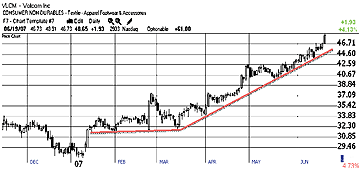Determining The Right Angle Makes All The Difference
The Angle Of Ascent
by Martha Stokes, CMT
Understanding the concept of the angle of ascent will help you make strong entries and protect your profits.
Successful traders know that technical analysis skills require an understanding of buy signals and indicators. Today, we tackle angle of ascent. Angle of ascent involves price, which is the most important aspect of technical analysis and an indicator onto itself. Yes, price is an indicator -- the most important of any. Why? Because the stock market, while closely tied to mathematical concepts, is even more closely related to biology. If that seems foreign, think of it this way. Humans are not mathematical formulas; we are biological creatures. We think with our minds and emotions and feel our way through life. Human beings move price action in the stock market. Consequently, the ability to analyze price action and determine what it is telling you is a crucial, and generally misunderstood, aspect of trading and investing.
Price analysis is overlooked so often that traders bond in solidarity at trade shows, discussion forums, and lecture circuits over the common problem. The gist of the issue is this: When traders go in search of stocks to trade, they often enter stocks just as a run is weakening or about to reverse. If you understand the concept of angle of ascent, you will be able to avoid weak entries and protect profits against bounces, whipsaws, and trend reversals.
WHAT IS IT?
The angle of ascent is the degree at which price rises in its trendline. It is relevant to all trading and investing timelines and can forewarn of weaker entries and topping and bottoming patterns before these patterns can be identified. Traders who use angle of ascent analysis increase their success rate by discarding weaker angle patterns and selecting more ideal entries for their trades.
Angle of ascent should not be confused with trendlines, which must touch at least three points to be a valid trendline. Rather, angle of ascent is concerned with two things:
• The most recent price action in relation to the trading style being appliedWhat makes this analysis so powerful is the understanding of physics (yes, back to science) and the nature of lift and velocity. Here's an analogy: Pilots know that the angle of ascent on takeoff and landing is essential to success. If the takeoff is too steep, the plane will climb too fast, causing the wings to lose lift. This loss of lift will cause the airplane to stall. If the descent is too steep on the other end of the trip, the plane again will stall. You may have heard that the most dangerous part of flying involves the takeoff and landing, and this is why. Paying careful attention to angle of ascent ensures success.
• The angle at which price is moving upward or downward.

FIGURE 1: VLCM, DAILY. Here you see a sustainable angle of ascent as it rises out of a bottom to form a solid uptrend that was ideal for a position trade style entry.
In that respect, flying a plane and trading stocks are similar.
The entry (takeoff) and the exit (landing) are critical to success (or
failure) in stock and option trading. By developing necessary skills and
undergoing extensive training, a pilot avoids disaster. A trader should
do the same. Instead of thinking about what he is going to do once he reaches
his destination, the pilot is focused first on the angle of ascent as he
takes off.
In the same way, a trader should first plot the angle of ascent for any stocks that he has selected to trade. To determine if the angle of ascent is sustainable for a trending stock, a trader should first set the chart view to the appropriate timeline to study the trend angle of ascent.
...Continued in the September issue of Technical Analysis of STOCKS
& COMMODITIES
Excerpted from an article originally published in the September 2007
issue of Technical Analysis of STOCKS & COMMODITIES magazine. All rights reserved. © Copyright 2007, Technical Analysis, Inc.
Return to September 2007 Contents